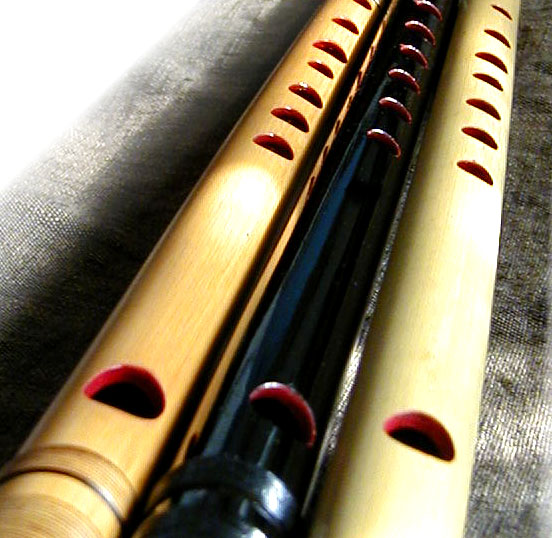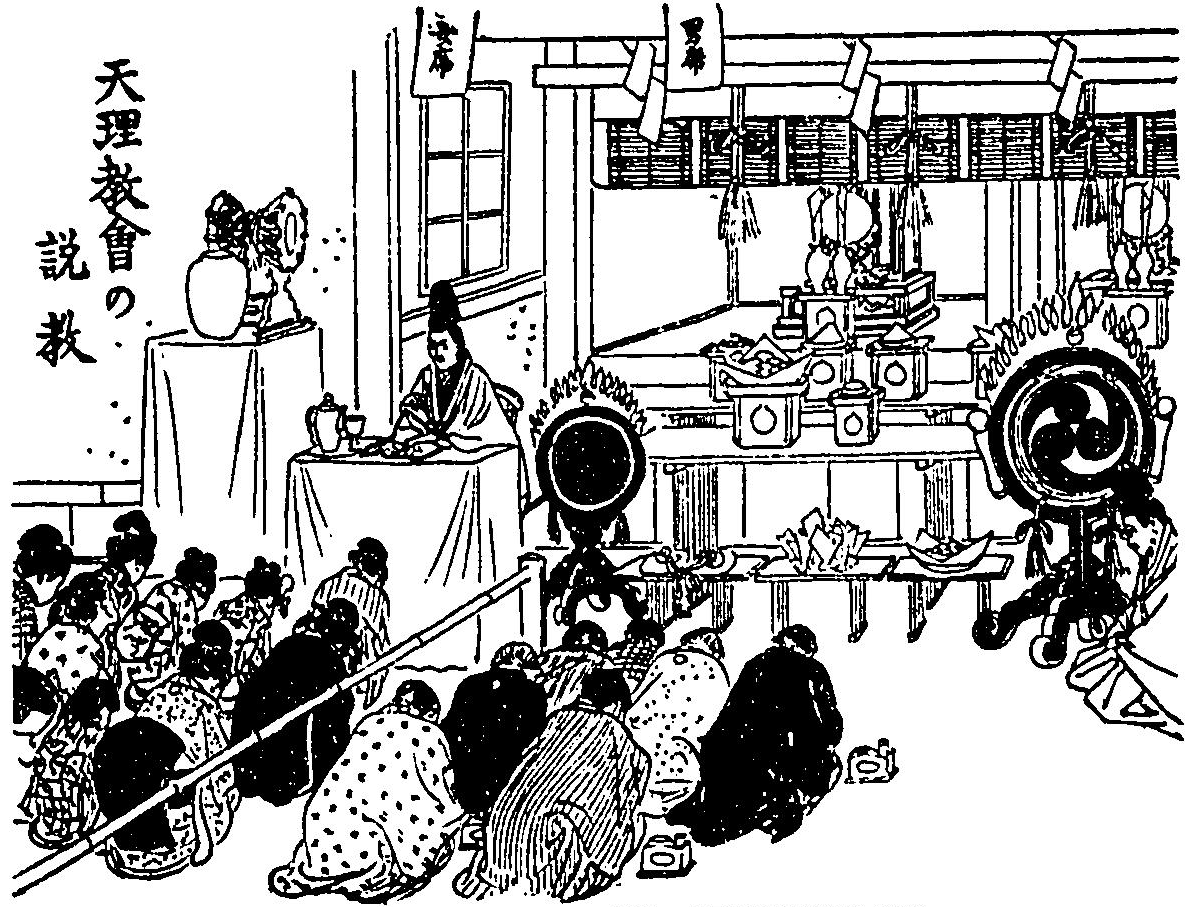|
Service (Tenrikyo)
In the Tenrikyo religion, the Service (おつとめ ''Otsutome'') is the most important prayer ritual, along with the Sazuke. The Service comes in fundamental forms (i.e. the Kagura Service and Teodori) and several variant forms (such as the Morning and Evening Service). The text to the Service is the ''Mikagura-uta,'' one of the three scriptures of Tenrikyo. Kagura Service The most important Service is the Kagura Service (''Kagura zutome''). This service is the masked dance that is performed around the Jiba (Tenrikyo), Kanrodai where Tenrikyo Church Headquarters – located in Tenri City, Japan – is situated. Hashimoto cites three meanings behind the performance of the Kagura Service–to represent God's creative power Tenrikyo creation narrative, at the time of human conception and thus inspire humankind to live the Joyous Life, to reconfirm Tenrikyo anthropology, humankind's relationship with God and the universe, and to realize the importance of living by God's original inten ... [...More Info...] [...Related Items...] OR: [Wikipedia] [Google] [Baidu] |
Jiba (Tenrikyo)
In the Tenrikyo religion, the Jiba (ぢば) is the ''axis mundi'' where adherents believe that God created humankind. The spot is located in the center of the main sanctuary at Tenrikyo Church Headquarters, located in Tenri, Nara, Japan. It is marked by a wooden pillar called the ''Kanrodai'' (かんろだい). Significance The significance of ''Jiba'' is described in all three Tenrikyo scriptures – the '' Ofudesaki'', the '' Mikagura-uta'', and the '' Osashizu''. Phrases in the scriptures define ''Jiba'' as simply "the origin," and more specifically "the origin where God began human beings," "the origin of this world," and "the origin of all things." In the context of Tenrikyo's creation narrative, the ''Jiba'' is said to be the spot where ''Izanagi-no-Mikoto'' and ''Izanami-no-Mikoto,'' the models of husband and wife, conceived the first children. The scriptures also assert that ''Jiba'' is the place where God the Parent and the everliving Oyasama reside. The ''Jiba'' ... [...More Info...] [...Related Items...] OR: [Wikipedia] [Google] [Baidu] |
Tenrikyo
is a Japanese new religion which is neither strictly monotheistic nor pantheistic, originating from the teachings of a 19th-century woman named Nakayama Miki, known to her followers as "Oyasama". Followers of Tenrikyo believe that God of Origin, God in Truth, known by several names including "Tsukihi," " Tenri-Ō-no-Mikoto" and "Oyagamisama (God the Parent)" revealed divine intent through Miki Nakayama as the Shrine of God and to a lesser extent the roles of the Honseki Izo Iburi and other leaders. Tenrikyo's worldly aim is to teach and promote the Joyous Life, which is cultivated through acts of charity and mindfulness called . The primary operations of Tenrikyo today are located at Tenrikyo Church Headquarters (Tenri, Nara, Japan), which supports 16,833 locally managed churches in Japan,Japanese Ministry of Education. ''Shuukyou Nenkan, Heisei 14-nen'' (宗教年鑑平成14年). 2002. the construction and maintenance of the and various community-focused organisations. It h ... [...More Info...] [...Related Items...] OR: [Wikipedia] [Google] [Baidu] |
Koto (instrument)
The is a Japanese plucked half-tube zither instrument, and the national instrument of Japan. It is derived from the Chinese and , and similar to the Mongolian , the Korean and , the Vietnamese , the Sundanese and the Kazakhstan . Koto are roughly in length, and made from Paulownia wood ('' Paulownia tomentosa'', known as ). The most common type uses 13 strings strung over movable bridges used for tuning, different pieces possibly requiring different tuning. 17-string koto are also common, and act as bass in ensembles. Koto strings are generally plucked using three fingerpicks (), worn on the first three fingers of the right hand. Names and types The character for ''koto'' is , although is often used. However, (''koto'') is the general term for all string instruments in the Japanese language,(jaKotobank koto/ref> including instruments such as the , , , , , and so on. When read as , it indicates the Chinese instrument . The term is used today in the same way. The term ... [...More Info...] [...Related Items...] OR: [Wikipedia] [Google] [Baidu] |
Ōyamato Shrine
is a Shinto shrine located in Tenri, Nara in Japan. In the time of Emperor Sujin there was a crisis. Amaterasu ( via the Yata-no-Kagami and the Kusanagi sword) and Yamato Okunitama, the tutelary deity of Yamato, were originally worshipped in the great hall of the imperial palace. When a series of plagues broke out during Emperor Sujin's reign, he "dreaded ..the power of these Gods, and did not feel secure in their dwelling together." He thus entrusted the mirror and the sword to his daughter Toyosukiirihime, who brought them to the village of Kasanuhi, and delegated the worship of Yamato Okunitama to another daughter, ,but her health began to fail shortly afterward. It is recorded that Nunakiiri-hime became emaciated after losing all of her hair, which rendered her unable to perform her duties. would conduct the Okunitama rites replacing the emaciated . would be the ancestor of the Yamato clan. This replacement is taken as a shift towards more patriarchai religion. When t ... [...More Info...] [...Related Items...] OR: [Wikipedia] [Google] [Baidu] |
Osaka
is a designated city in the Kansai region of Honshu in Japan. It is the capital of and most populous city in Osaka Prefecture, and the third most populous city in Japan, following Special wards of Tokyo and Yokohama. With a population of 2.7 million in the 2020 census, it is also the largest component of the Keihanshin Metropolitan Area, which is the second-largest metropolitan area in Japan and the 10th largest urban area in the world with more than 19 million inhabitants. Osaka was traditionally considered Japan's economic hub. By the Kofun period (300–538) it had developed into an important regional port, and in the 7th and 8th centuries, it served briefly as the imperial capital. Osaka continued to flourish during the Edo period (1603–1867) and became known as a center of Japanese culture. Following the Meiji Restoration, Osaka greatly expanded in size and underwent rapid industrialization. In 1889, Osaka was officially established as a municipality. The const ... [...More Info...] [...Related Items...] OR: [Wikipedia] [Google] [Baidu] |
Koto (musical Instrument)
The is a Japanese plucked half-tube zither instrument, and the national instrument of Japan. It is derived from the Chinese and , and similar to the Mongolian , the Korean and , the Vietnamese , the Sundanese and the Kazakhstan . Koto are roughly in length, and made from Paulownia wood ('' Paulownia tomentosa'', known as ). The most common type uses 13 strings strung over movable bridges used for tuning, different pieces possibly requiring different tuning. 17-string koto are also common, and act as bass in ensembles. Koto strings are generally plucked using three fingerpicks (), worn on the first three fingers of the right hand. Names and types The character for ''koto'' is , although is often used. However, (''koto'') is the general term for all string instruments in the Japanese language,(jaKotobank koto/ref> including instruments such as the , , , , , and so on. When read as , it indicates the Chinese instrument . The term is used today in the same way. The term ... [...More Info...] [...Related Items...] OR: [Wikipedia] [Google] [Baidu] |
Shinobue
The ''shinobue'' (kanji: 篠笛; also called ''takebue'' (kanji: 竹笛) in the context of Japanese traditional arts) is a Japanese transverse flute or fue that has a high-pitched sound. It is found in hayashi and nagauta ensembles, and plays important roles in noh and kabuki theatre music. It is heard in Shinto music such as '' kagura-den'' and in traditional Japanese folk songs. There are two styles: ''uta'' (song) and ''hayashi'' (festival). The uta is properly tuned to the Western scale, and can be played in ensembles or as a solo Solo or SOLO may refer to: Arts and entertainment Comics * ''Solo'' (DC Comics), a DC comics series * Solo, a 1996 mini-series from Dark Horse Comics Characters * Han Solo, a ''Star Wars'' character * Jacen Solo, a Jedi in the non-canonical ' ... instrument. See also * Ryuteki * Bamboo musical instruments External linksRon Korb's Asian Flute Gallery(features description and drawing of the Shinobue and other Japanese flutes)(features art ... [...More Info...] [...Related Items...] OR: [Wikipedia] [Google] [Baidu] |
Kane (instrument)
The is a type of dish-shaped Bell (instrument), bell from Japan. The is often found in traditional Japanese music or Min'yō. Although sometimes suspended from a bar, it is more common for a musician to hold the bell in place with one hand beat it with the other using a special mallet, often made from bone. The ''kane'' makes three distinct sounds: ''chon'' - hitting the middle; ''chi'' - hitting the inside edge; and ''ki'' - reversing the stroke. This kind of onomatopoeic mnemonic or ''shouga'' is common in Japanese music. There are several sizes of ''kane'', such as the ''atarigane'' or the ''surigane''. ''Kane'' are also used in Buddhist or Shinto ceremonies. In temples, they may be used to signify time or alert people to certain events. See also *Bonshō *Suzu (bell), Suzu *Bell (instrument)#Japanese bells, Japanese bells References Japanese musical instruments Bells (percussion) Asian percussion instruments {{Japan-music-stub ... [...More Info...] [...Related Items...] OR: [Wikipedia] [Google] [Baidu] |
Tenrikyo Homeshrine
is a Japanese new religion which is neither strictly monotheistic nor pantheistic, originating from the teachings of a 19th-century woman named Nakayama Miki, known to her followers as "Oyasama". Followers of Tenrikyo believe that God of Origin, God in Truth, known by several names including "Tsukihi," "Tenri-Ō-no-Mikoto" and "Oyagamisama (God the Parent)" revealed divine intent through Miki Nakayama as the Shrine of God and to a lesser extent the roles of the Honseki Izo Iburi and other leaders. Tenrikyo's worldly aim is to teach and promote the Joyous Life, which is cultivated through acts of charity and mindfulness called . The primary operations of Tenrikyo today are located at Tenrikyo Church Headquarters (Tenri, Nara, Japan), which supports 16,833 locally managed churches in Japan,Japanese Ministry of Education. ''Shuukyou Nenkan, Heisei 14-nen'' (宗教年鑑平成14年). 2002. the construction and maintenance of the and various community-focused organisations. It has ... [...More Info...] [...Related Items...] OR: [Wikipedia] [Google] [Baidu] |
Cosmological
Cosmology () is a branch of physics and metaphysics dealing with the nature of the universe. The term ''cosmology'' was first used in English in 1656 in Thomas Blount's ''Glossographia'', and in 1731 taken up in Latin by German philosopher Christian Wolff, in ''Cosmologia Generalis''. Religious or mythological cosmology is a body of beliefs based on mythological, religious, and esoteric literature and traditions of creation myths and eschatology. In the science of astronomy it is concerned with the study of the chronology of the universe. Physical cosmology is the study of the observable universe's origin, its large-scale structures and dynamics, and the ultimate fate of the universe, including the laws of science that govern these areas. It is investigated by scientists, such as astronomers and physicists, as well as philosophers, such as metaphysicians, philosophers of physics, and philosophers of space and time. Because of this shared scope with philosophy, theories i ... [...More Info...] [...Related Items...] OR: [Wikipedia] [Google] [Baidu] |








